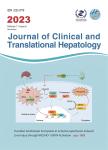Update on Management of Portal Vein Thrombosis and the Role of Novel Anticoagulants
作者机构:Albany Medical CollegeAlbanyNYUSA Department of RadiologyAlbany Medical Center HospitalAlbanyNYUSA Department of GastroenterologyAlbany Medical Center HospitalAlbanyNYUSA
出 版 物:《Journal of Clinical and Translational Hepatology》 (临床与转化肝病杂志(英文版))
年 卷 期:2019年第7卷第2期
页 面:154-164页
核心收录:
学科分类:1002[医学-临床医学] 100201[医学-内科学(含:心血管病、血液病、呼吸系病、消化系病、内分泌与代谢病、肾病、风湿病、传染病)] 10[医学]
主 题:Portal vein Thrombosis Liver cirrhosis Neoplasm Anticoagulant
摘 要:The clinical management of portal vein thrombosis(PVT)remains ambiguous due to its heterogeneous presentations and its associations with liver disease,malignancy,and hypercoagulable *** natural history and clinical outcome of PVT are highly variable,dependent upon size,extent and degree of the thrombotic occlusion,as well as the physiological impact of patient *** existing clinical guidelines consistently recommend low molecular weight heparin or vitamin K antagonist anticoagulation in cirrhotic patients with symptomatic acute PVT,management of asymptomatic and chronic PVT may need to be determined on a case-by-case basis,factoring in the state of underlying liver *** general,patients with PVT and underlying malignancy should be anticoagulated to alleviate symptoms and prevent recurrences that could disrupt the cancer ***,existing clinical data does not support routine anticoagulation of cirrhotic patients with asymptomatic PVT in the absence of underlying *** low molecular weight heparin and vitamin K antagonist remain the most commonly used agents in PVT,an emerging body of clinical evidence now suggests that direct-acting oral anticoagulants may be used safely and effectively in *** such,direct-acting oral anticoagulants may offer a more convenient anticoagulation alternative for PVT management in future practice.



